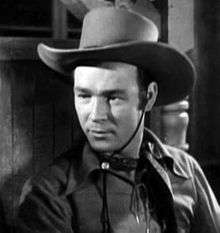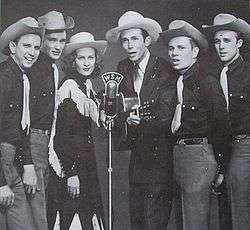1940s in music
For music from a year in the 1940s, go to 40 | 41 | 42 | 43 | 44 | 45 | 46 | 47 | 48 | 49
This article includes an overview of the major events and trends in popular music in the 1940s.
In the Developed World, Swing, Big band, Jazz, Latin and Country music dominated and defined the decade's music. After World War II, the big band sounds of the earlier part of the decade had been gradually replaced by crooners and vocal pop.
The U.S. and North America
Pop
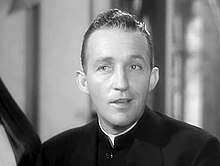
Ragtime can be described as the first truly American music genre and it remained popular for over 20 years. After its best-known exponent, Scott Joplin, died in 1917, the genre faded. As the 1920s unfolded, jazz rapidly took over as the dominant form of popular music in the United States.
But with the Stock Market Crash of 1929 and the onset of the Great Depression, the market for music rapidly dried up. Dance halls emptied out and musicians could not find work. By the middle of the 1930s however, with signs of economic recovery approaching, a turnaround in the fortunes of the music industry began. The era of big band swing had started.
In addition, a new form of popular music, crooning, emerged during the early 1930s. Technology played a large part in the development of this style, as electronic sound recording had emerged near the end of the 1920s and replaced the earlier acoustic recording. While singers such as Al Jolson and Billy Murray had recorded songs by yelling into a Victrola horn, as this was the only way to get audible sound with acoustic recording, the new electronic equipment allowed for a softer, more intimate style of singing. Many of the older singers such as Jolson and Murray consequently fell out of favor during the 1930s with changing tastes (although Al Jolson managed a successful career comeback after World War II).
Bing Crosby was the leading figure of the crooner sound as well as its most iconic, defining artist. By the 1940s, he was an entertainment superstar who mastered all of the major media formats of the day, movies, radio, and recorded music. Other popular singers of the day included Cab Calloway and Eddie Cantor.
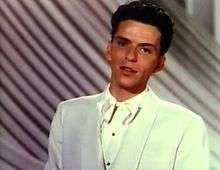
Bandleaders such as the Dorsey Brothers often helped launch the careers of vocalists who went on to popularity as solo artists, such as Frank Sinatra, who rose to fame as a singer during this time.[1] Sinatra's vast appeal to the "bobby soxers" revealed a whole new audience for popular music, which had generally appealed mainly to adults up to that time, making Sinatra the first teen idol. Sinatra's music mostly attracted young girls to his concerts. This image of a teen idol would also be seen with future artists such as Elvis Presley and The Beatles. Sinatra's massive popularity was also one of the reasons why the big band music declined in popularity; major record companies were looking for crooners and pop singers to attract a youth audience due to his success. Frank Sinatra would go on to become one of the most successful artists of the 1940s and one of the best selling music artists of all time. Sinatra remained relevant through the 1950s and 60s, even with rock music being the dominant form of music in his later years. In the later decades, Sinatra's music would be mostly aimed at an older adult audience. Sinatra became one of the most respected and critically acclaimed music artists of all time.
Big band swing could variably be an instrumental style or accompany a vocalist. In comparison to its loud, brash, rhythmic sound stood the "sweet" bands which played a softer, more melodic style. The most notable of these, in no small part thanks to a long postwar TV career, was the band of Lawrence Welk.
While swing bands could be found in most major cities during the 1930s-1940s, the most popular and famous were the bands of Glenn Miller, Benny Goodman, and Artie Shaw, which had national followings and sold huge numbers. World War II brought an end to big band swing as many musicians were conscripted into the armed forces and travel restrictions made it hard for bands to tour. In 1944, Glenn Miller was killed when his plane crashed into the English Channel en route to a USO show in France. His death is widely considered to mark the close of the swing era.
After the war, a combination of factors such as changing demographics and rapid inflation made large bands unprofitable, so that popular music in the US came to be dominated instead by traditional pop and crooners, as well as bebop and jump blues.[1]
Jazz
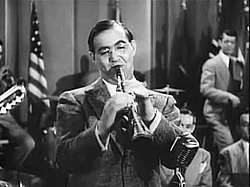
In the early 1940s, bebop emerged, led by Charlie Parker, Dizzy Gillespie, Thelonious Monk and others. It helped to shift jazz from danceable popular music towards a more complex "musician's music." Differing greatly from swing, early bebop divorced itself from dance music, establishing itself more as an art form but lessening its potential popular and commercial value. Since bebop was meant to be listened to, not danced to, it used faster tempos.
The swing era lasted until the mid-1940s, and produced popular tunes such as Duke Ellington's "Cotton Tail" (1940) and Billy Strayhorn's "Take the 'A' Train" (1941). When the big bands struggled to keep going during World War II, a shift was happening in jazz in favor of smaller groups. Some swing era musicians, like Louis Jordan, later found popularity in a new kind of music, called "rhythm and blues", that would evolve into rock and roll in the 1950s.
By the end of the 1940s, the nervous energy and tension of bebop was replaced with a tendency towards calm and smoothness, that eventually influenced the birth of cool jazz, which favoured long, linear melodic lines in the 1950s.
By the 1940s, Dixieland jazz revival musicians like Jimmy McPartland, Eddie Condon and Bud Freeman had become well-known and established their own unique style. Most characteristically, players entered solos against riffing by other horns, and were followed by a closing with the drummer playing a four-bar tag that was then answered by the rest of the band.
Some of the most notable Jazz artists of the 1940s include Ella Fitzgerald, Billie Holiday, Louis Armstrong and also Nat King Cole.
Country music
Throughout the 1930s and 1940s, cowboy songs, or Western music, became widely popular through the romanticization of the cowboy and idealized depictions of the west in Hollywood films. Singing cowboys, such as Roy Rogers and Gene Autry, sang cowboy songs in their films and became popular throughout the United States. Film producers began incorporating fully orchestrated four-part harmonies and sophisticated musical arrangements into their motion pictures.
In the post-war period, country music was called "folk" in the trades, and "hillbilly" within the industry.[2] In 1944, The Billboard replaced the term "hillbilly" with "folk songs and blues," and switched to "country" or "country and Western" in 1949.[3][4]
But while cowboy and Western music were the most popular styles, a new style – honky tonk – would take root and define the genre of country music for decades to come. The style meshed Western swing and blues music; featured rough, nasal vocals backed by instruments such as the guitar, fiddle, string bass, and steel guitar; and had lyrics that focused on tragic themes of lost love, adultery, loneliness, alcoholism and self-pity. One of the earliest successful practitioners of this style was Ernest Tubb, a Crisp, Texas native who had perfected his style on several Texas radio stations in the mid- to late-1930s. In 1940, he gained a recording contract with Decca Records, and a year later released his standard "Walking the Floor Over You." The single became a hit and sold over 1 million copies. Allmusic critic David Vinopal called "Walking the Floor Over You" the first honky tonk song that launched the musical genre itself.[5] As the decade progressed, the style was picked up by Floyd Tillman and Hank Williams, and by the end of the 1940s was the predominant style in country music.
Williams, a Butler County, Alabama native, began earning a reputation as both a songwriter and a performing artist. Using traditional honky-tonk themes, Williams grew to become one of the most important country performers of all time. His recording of "Lovesick Blues" (and its flip side, "I'm So Lonesome I Could Cry") in 1949 remains a landmark in both country and popular music to this day. But even by the late 1940s, it became well known that Williams drank heavily, and his personal problems would continue to grow as the 1950s dawned. Still, his overall style inspired countless artists in country and other styles of music, including rock music, and his songs would be performed by numerous artists in many styles.
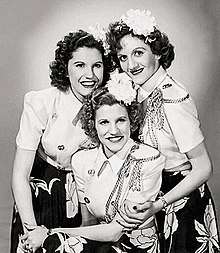
On August 25, 1945 Jenny Lou Carson became the first woman to write a No. 1 country music hit when "You Two-Timed Me One Time Too Often," performed by Tex Ritter, reached the top of the Billboard Most Played Juke Box Folk Records.[6] In 1949 Carson had another No. 1 country music hit as a songwriter when "Don't Rob Another Man's Castle," performed by Eddy Arnold, topped the Billboard Folk Best Seller Charts.[7] From 1945 to 1955 Carson was one of the most prolific songwriters in country music. Women weren't absent from the scene as vocalists; in fact, the No. 1 song on Billboard magazine's very first Most Played Juke Box Folk Records chart, dated January 8, 1944, saw The Andrews Sisters get co-credit along with Bing Crosby on "Pistol Packin' Mama." In 1949, Margaret Whiting teamed with Jimmy Wakely to have a No. 1 country and pop hit, a cover of the Floyd Tillman song "Slippin' Around." Kitty Wells was a popular concert attraction, performing with her husband Johnnie Wright and his duet partner, Jack Anglin; and Wilma Lee Cooper was prominently featured on recordings with her husband, Stoney. Other popular female acts were Patsy Montana, Martha Carson, The Maddox Brothers and Rose, Molly O'Day with the Cumberland Mountain Folks, and Lulu Belle (of Lulu Belle and Scotty), while Mother Maybelle Carter re-formed the Carter Family with her daughters, Anita, June, and Helen and their popularity would only grow in time.
Eddy Arnold, known as "The Tennessee Plowboy," became an innovator of crossover music, or music of one particular genre (in this case, country) that was popular among mainstream audiences. His style combined elements of refined honky tonk with popular music sounds, evident on hits like "That's How Much I Love You," "I'll Hold You In My Heart ('Til I Can Hold You In My Arms)," "Anytime" and "Boquet of Roses," and several of these songs charted on both the Billboard country and pop charts. He was so dominant that by 1948, five of that year's six No. 1 songs on Billboards' country chart bore Arnold's name, a record that Charlie Rich would tie 26 years later but otherwise has been unmatched. Arnold would go on to score more than 150 chart hits during a career that spanned until his death in 2008.
Other Trends
- In 1941 Les Paul designed and built the first solid-body electric guitar.
- In 1942 Bing Crosby recorded and released the single "White Christmas", which became the best-selling single of all time, with estimated sales in excess of 50 million copies worldwide.[8][9][10]
- In 1948 Columbia Records introduced the 33⅓ rpm LP (“long playing”) record at New York City's Waldorf-Astoria Hotel, featuring 25 minutes of music per side.
- In 1949 RCA Victor introduced the 45 rpm record, featuring 8 minutes of music.
Europe
Edith Piaf, Charles Trenet, Tino Rossi, were popular French singers.
Latin America

- Pedro Infante was a Mexican actor and singer. Hailed as one of the greatest actors of the Golden Age of Mexican cinema, he is considered an idol in Mexico and Latin American countries.
- Jorge Negrete was Mexican actor and singer, other of the greatest actors of the Golden Age of Mexican cinema, he is considered " El Charro Cantor" in Latin American countries.
- María Grever was the first female Mexican composer to achieve international acclaim.
- In 1948 Perez Prado recorded the first Mambo in Mexico for RCA Victor
- Genoveva Jimenez was a famous Latin American musician during the late 1940s.
Asia
In China, the 1940s was the golden era of Mandarin pop songs which were collectively termed 'Shidaiqu', literally 'songs of the era'. Shanghai Pathe Records, then belonging to EMI, emerged to be the leading record company in China and featured a blend of Chinese melodies and Western orchestrations as well as Big Band Jazz elements in arrangements of music, leading to their superseding traditional Chinese operas in radio broadcasts. With the help of growing radio audience in the nation, Shidaiqu successfully became prevalent and listening to Mandarin pop songs was regarded as trendy. Among all Chinese contemporary singers, Zhou Xuan, Yao Li (also known as Hue Lee), Wu Yingyin, Bai Guang, Bai Hong, Gong Qiuxia and Li Xianglan were the seven most famous artists (七大歌星), who gained nationwide popularity. Zhou Xuan was the most representative of all, who later became one of the emblematic and legendary figures in the history of Chinese pop songs. In addition, despite the ravages of the Japanese occupation, there saw an immense development and maturation in the Chinese movie industry. Very often, pop songs were intermingled with episodes in films, providing the audience with multiple entertainment at one time. Nonetheless, little attention was paid on the groundbreaking breakthroughs of Chinese Mandarin pop songs in the 1940s, both by the academia and the community in China as well as Western countries. Shidaiqu had its influence even in Hong Kong and Taiwan music in the 1950s and 1960s as well as in Malaysian and Singaporean Chinese communities. Rose, Rose, I Love you, the renowned song presented by Frankie Laine, and An Autumn Melody, were two symbolic Shidaiqu.
In Japan, Nihon Columbia and Nihon Victor were two of the larger record companies. Blues, boogie-woogie and jazz were popular. Ryouichi Hattori was a popular composer, and Shizuko Kasagi was one of the popular singers.
See also
References
- Gilliland, John (1994). Pop Chronicles the 40s: The Lively Story of Pop Music in the 40s (audiobook). ISBN 978-1-55935-147-8. OCLC 31611854. Tape 1.
- Country Music Goes To War By Charles K. Wolfe, James Edward Akenson. 2005. University Press of Kentucky. page = 55. ISBN 0-8131-2308-9 Google Books
- Long Steel Rail: The Railroad in American Folksong. By Norm Cohen, David Cohen. University of Illinois Press. 2000. page 31. ISBN 0-252-06881-5, ISBN 978-0-252-06881-2
- Google Books.
- Vinopal, David. "Ernest Tubb Biography". Allmusic. Retrieved January 3, 2013.
- Whitburn, Joel (2004). The Billboard Book Of Top 40 Country Hits: 1944-2006, Second edition. Record Research. p. 292.
- Whitburn, Joel (2004). The Billboard Book Of Top 40 Country Hits: 1944-2006, Second edition. Record Research. p. 29.
- Guinness Book of Records, 2007 Edition, page 187 Archived 2015-03-19 at the Wayback Machine
- Guinness Book of Records, 2008 Edition, page 181
- Guinness Book of Records, 2009 Edition, pp. 14, 15 & 169. Archived 2013-02-26 at the Wayback Machine

